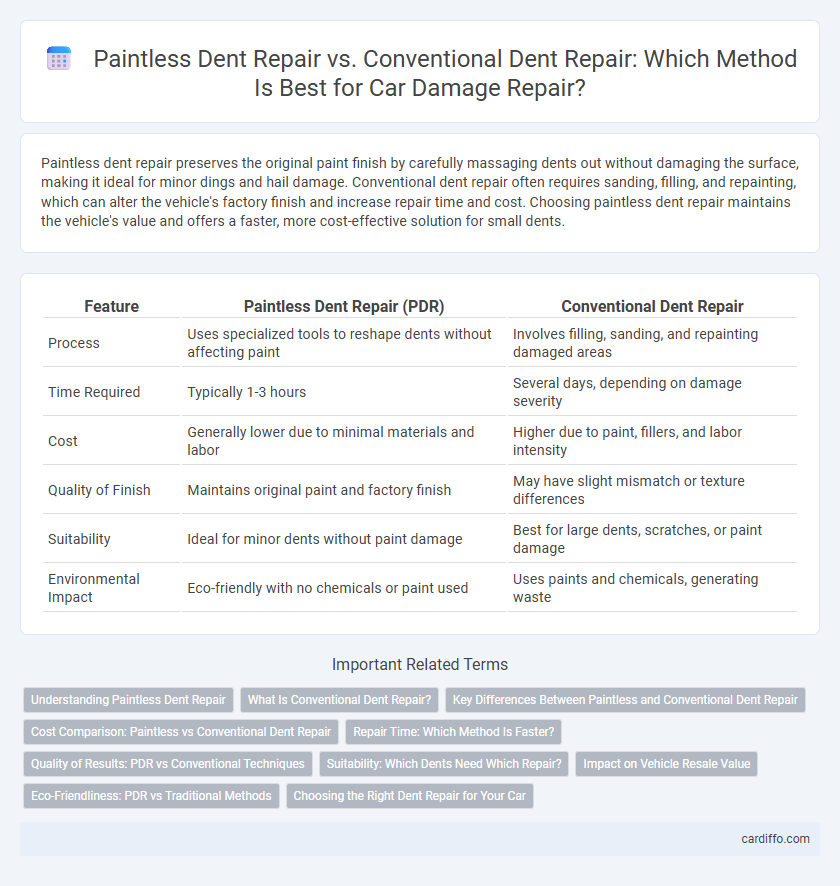Paintless dent repair preserves the original paint finish by carefully massaging dents out without damaging the surface, making it ideal for minor dings and hail damage. Conventional dent repair often requires sanding, filling, and repainting, which can alter the vehicle's factory finish and increase repair time and cost. Choosing paintless dent repair maintains the vehicle's value and offers a faster, more cost-effective solution for small dents.
Table of Comparison
| Feature | Paintless Dent Repair (PDR) | Conventional Dent Repair |
|---|---|---|
| Process | Uses specialized tools to reshape dents without affecting paint | Involves filling, sanding, and repainting damaged areas |
| Time Required | Typically 1-3 hours | Several days, depending on damage severity |
| Cost | Generally lower due to minimal materials and labor | Higher due to paint, fillers, and labor intensity |
| Quality of Finish | Maintains original paint and factory finish | May have slight mismatch or texture differences |
| Suitability | Ideal for minor dents without paint damage | Best for large dents, scratches, or paint damage |
| Environmental Impact | Eco-friendly with no chemicals or paint used | Uses paints and chemicals, generating waste |
Understanding Paintless Dent Repair
Paintless Dent Repair (PDR) is a technique that removes minor dents and dings without affecting the original paint, preserving the vehicle's factory finish and reducing repair time. Unlike conventional dent repair, which involves sanding, filling, and repainting, PDR uses specialized tools to gently massage the dent from underneath the panel, maintaining structural integrity. This method is most effective on small-to-medium dents where the paint surface remains intact, offering cost-effective and environmentally friendly dent removal.
What Is Conventional Dent Repair?
Conventional dent repair involves sanding, filling, and repainting the damaged area to restore a vehicle's surface, often requiring more time and materials compared to paintless dent repair. This method is typically used for larger dents or damage where the paint surface is cracked or compromised. The process involves removing paint around the dent, applying body filler, sanding it smooth, and repainting the area to match the original finish.
Key Differences Between Paintless and Conventional Dent Repair
Paintless dent repair (PDR) preserves the original paint by using specialized tools to gently massage dents from the inside, ideal for minor dings and hail damage. Conventional dent repair involves filler, sanding, and repainting, suitable for larger or more complex dents where the paint surface is damaged. PDR typically offers faster turnaround, lower costs, and maintains the vehicle's factory finish, while conventional repair provides comprehensive restoration for severe damage.
Cost Comparison: Paintless vs Conventional Dent Repair
Paintless dent repair (PDR) generally costs 50% to 70% less than conventional dent repair due to minimal labor and materials required. While PDR averages between $75 and $150 per dent, conventional methods often range from $200 to $500 or more depending on the size and severity of the damage. Choosing PDR can significantly reduce expenses, especially for minor dents without paint damage, making it a cost-effective alternative to traditional body shop repairs.
Repair Time: Which Method Is Faster?
Paintless dent repair (PDR) typically requires 30 minutes to a few hours, as it involves carefully massaging the dented metal without affecting the paint. Conventional dent repair can take several days due to the need for filling, sanding, priming, and repainting, with drying times extending the process significantly. The faster turnaround of PDR makes it the preferred choice for minor dents and dings when immediate restoration is a priority.
Quality of Results: PDR vs Conventional Techniques
Paintless dent repair (PDR) preserves the original factory paint, ensuring a seamless finish without the risk of color mismatch or paint damage common in conventional dent repair. PDR delivers high-quality results for minor to moderate dents by carefully massaging the metal back to its original shape, maintaining the vehicle's resale value. Conventional techniques may achieve better results for severe damage but often require repainting, which can affect the overall aesthetic and durability of the repair.
Suitability: Which Dents Need Which Repair?
Paintless dent repair (PDR) is ideal for minor dents and dings where the paint surface remains intact, such as hail damage or door dings. Conventional dent repair is better suited for larger, more severe dents involving paint damage or creases that require filling, sanding, and repainting. Choosing the appropriate method depends on dent size, location, and paint condition to ensure optimal restoration results.
Impact on Vehicle Resale Value
Paintless dent repair (PDR) preserves the vehicle's original paint, maintaining factory finish and significantly enhancing resale value by avoiding repaint-related depreciation. Conventional dent repair often requires repainting, which can lead to color mismatch and lower perceived vehicle quality, negatively impacting resale price. Buyers and appraisers typically value vehicles with PDR more favorably due to the seamless restoration and preservation of the vehicle's authenticity.
Eco-Friendliness: PDR vs Traditional Methods
Paintless dent repair (PDR) significantly reduces environmental impact by eliminating the need for paint, solvents, and chemical-based fillers used in conventional dent repair. This method conserves raw materials and produces minimal waste, contributing to lower carbon emissions throughout the repair process. In contrast, traditional dent repair often involves repainting and body filler application, which generate hazardous waste and increase energy consumption, making PDR a more eco-friendly alternative.
Choosing the Right Dent Repair for Your Car
Paintless dent repair (PDR) preserves the original paint finish by using specialized tools to gently massage dents from the inside, making it ideal for minor dings and hail damage. Conventional dent repair involves sanding, filling, and repainting, which is better suited for larger dents or where the paint is damaged. Selecting the right dent repair method depends on dent size, location, and paint condition to ensure optimal results and maintain your car's value.
Paintless dent repair vs Conventional dent repair Infographic

 cardiffo.com
cardiffo.com